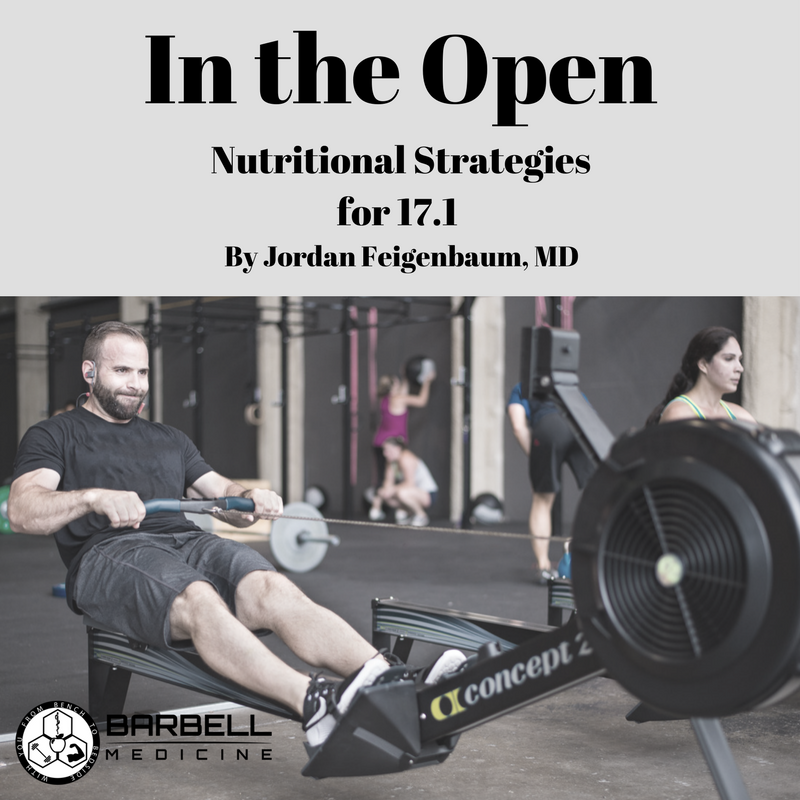17.1 (<<<PDF available here)
A brief introduction and then we can get right into this. I’m Jordan. I’m a lifter, a doctor, and I help people with their nutrition, programming, technique, or existential crises. I’ve had the fortune to work with world-class competitors on many different stages including CrossFit Games level athletes. I get offended on the inside when people ask if I “just do macros”, but I am a fan of objectively measured intake when it is appropriate.
In any event, I thought it’d be cool to put out some information each week about how I’d plan a model athlete’s eating and supplement strategy relative to the workout. Since the duration and components of the workouts tend to be pretty similar, I imagine there will be some repetition in what I advise, but hey- you never know!
Also, it should be said that I would not advise anyone to make huge changes to their eating habits the day of the open workout. That’s too much risk for something to go poorly in my opinion. That being said, here’s my 0.02:
We’re looking at about a 10-20 minutes for our duration for this workout and while I don’t think there is anything unusual about the exercises, domain, or energy systems that would make me do anything crazy, I do think this is a workout that “bubble competitors”, i.e. those who are on the bubble for making it to regionals, will likely repeat a few times once scores start coming in (though I think that shouldn’t be allowed. See here). My rationale is that it’s unlikely that doing this workout will come at a significant cost to the athete’s overall fatigue and there is a low likelihood of a torn hand or similar. On the other hand, those with a history of achilles or plantar fasciitis issues may consider the risk:benefit of exposing themselves to the stress of the workout again.
With that in mind, we’re going to want to maximize recovery rate and performance. I also think we should consider that the flopping around, jumping, and repeated positional changes the burpee box jumps may make the athlete’s stomach upset if they eat too close to the workout. Additionally, I think that there is a risk of orthostatic type lightheadedness with the dumbbell snatches if someone was not well hydrated.
How I would manage the meal timing bit is by having a pre-workout meal, e.g. 30% ish of your daily carbs, minimal fats*, and a good protein source (20-40g), 2-3 hours prior to doing the WOD. I’d then do 5-10g of BCAAs (or 1 serving GainzZz Rx) + caffeine about 30 min prior to the workout. Afterward, I recommend hopping on an assault bike or air dyne for 10-15 minutes to cool down and do 1 scoop whey, 10g BCAAs, or another serving of GainzZz Rx. Following that, I would recommend eating a meal after 17.1 (3-4 hours after your previous meal.
Again, my feeling is that the DB snatches require a lot of positional change and grip work on top of the burpees so you’re going to want to make sure sodium intake and hydration levels are on point. My stock recommendation for sodium intake in athletes is to add 700-800mg per liter of fluid and this is about 1.5-2 grams of table salt. I do not recommend sea salt, as there are varying concentrations of sodium within sea salt, as little as 10% sometimes and this ultimately does not help with sodium intake. With respect to fluids, I would plan to hydrate well, e.g. about 3L fluids in before you do the workout if training at night. I would also recommend drinking (water) as you want to the hour prior to 17.1. Don’t try and force fluids, as there is no benefit to doing that based on evidence, only detriment. Heck, even the 2% loss in body weight from sweating causing decreased performance isn’t terribly well proven. It’s more so that if you try and drink more or less than you want, you do worse in the event coming up.
Finally, if you respond positively to caffeine on workouts, I would use caffeine for this since it’s likely to get you “up” for the workout psychologically. The typical dose range is 3-9mg/kg bodyweight, but personal tolerance is very important to assess so you keep that in mind when dosing your cold brews 🙂
Now go crush it, everyone! See you guys next week.
Jordan Feigenbaum, the owner of Barbell Medicine, has an extensive academic background including a Bachelors of Science in Biology, Master’s of Science in Anatomy and Physiology, and Doctor of Medicine. Jordan also holds accreditations from many professional training organizations and is a staff member for select Starting Strength Seminars. He’s been coaching folks since 2008 and as a competitive powerlifter, Jordan has competition best lifts of a 640lb squat, 430lb bench press, and 725lb deadlift as a 198lb raw lifter. He can be contacted via email at info@barbellmedicine.com
